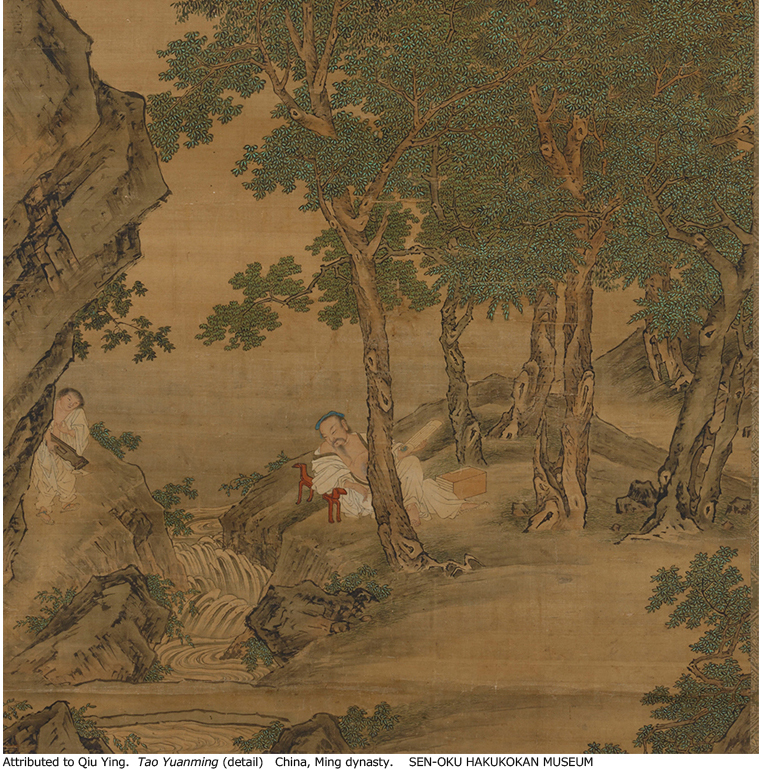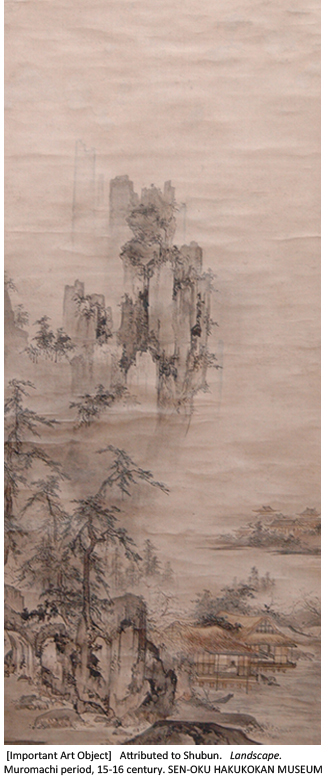Joyful Seclusion- Mindfulness of the Literati at SEN-OKU HAKUKOKAN MUSEUM TOKYO
SEN-OKU HAKUKOKAN MUSEUM TOKYO is now holding a special exhibition “Joyful Seclusion- Mindfulness of the Literati” from September 2nd to October 15th, 2023. Mindfulness refers to a peaceful state of mind. We are not alone in our modern world in seeking this state of mindfulness and wishing to get away from hustles and bustles to pursue seclusion, purity, and elegance.
This exhibition features paintings of landscapes revealing images of ideal hermitages and respectful Chinese hermit, as well as precious exquisite stationery in their quiet lives. We might find tips to live out our lives through the experience of mindfulness by literati of a bygone era.
Unlike “retirement” in which one simply quits a job and a lifestyle quietly, seclusion refers to living in peace, away from others and human relationships. When we are too busy or pressurized, we crave for some soothing moments with magnificent nature, though it’s extremely difficult. We long for a place where we can be ourselves truly, without being bothered by emails and phone calls.

Our ancestors enjoyed viewing paintings and artifacts as the representation of “Jigo-Yugi”, away from all political and social constraints, a clean but playful life with freedom.
So, oriental landscape paintings and literature works often come with the theme of ideal life. In landscape painting, we find different seclusion styles from “joyful” ones of a slow life in the countryside to “radical” ones of an aggressive approach to the harsh realities of life. The four chapters of the work depict various styles in pursuit of such comfort and freedom.

Outline
1. Yearning for Freedom:The Concept of Seclusion and Hermits
Underlying the concept of seclusion is the principle of “unworldliness.” The ideal of seclusion was thought to be rejecting any material desires that might sway the human mind, such as wealth, rank, and glory, and living amid nature while surrendering to its providence. For those who held lofty ideals, achieving them in the real world often proved challenging. Rather than destroying themselves by compromising with society, recluses chose to hold firm to their ideals by living amid nature.
The works which feature people who are called recluses are introduced here, such as well-known ancient Chinese hermits such as Xu You, the Seven Sages of the Bamboo Grove, and Tao Yuanming, a poet from the Northern and Southern dynasties period (fourth through fifth century).

2. Images of Utopia
The Tale of the Peach-Blossom Spring by the Chinese poet Tao Yuanming, who was introduced in the previous section, depicts the Peach-Blossom Land, a paradise where people live freely in nature, governed only by its providence. This paradise went on to become a subject of yearning for many people who dreamed of leading a quiet life there, appreciating the changing seasons and enjoying tea and alcohol.
However, this idyllic lifestyle was difficult to practice in the real world. Thus, people pursued their yearning for the Peach-Blossom Land through paintings and the tea ceremony as tools for attaining temporary serenity.
The works depicting the Peach-Blossom Land, connected by tranquil images of mountains and rivers, are introduced in this section.

3. Joyful Seclusion: A Peaceful Lifestyle
For recluses, who saw coexistence with nature as the ultimate truth, viewing spectacular natural scenery reminded them of the limits of human intellect, which led them to ponder the state of humanity. I believe that we who live today can greatly relate to these perspectives and ideas.
Ode to the Red Cliffs by the Chinese poet Su Shi (Su Dongpo) was especially beloved by recluses for its elegant descriptions of such amusement in nature, and it has inspired the creation of numerous paintings and craftworks. Recluses who amused themselves amid mountains and rivers were keenly aware of the insignificance of humans amid the grandeur of nature, and this seems to be reflected in how small human activities are depicted relative to nature in landscape paintings.
The works with the main themes of “waterfall viewing” and “studies,” are introduced in this section.

4. Companions Occasionally Enjoying Refinement
There is a Japanese saying, “Work in the field on fine days, and read books in rainy weather.” This phrase represents leading a cloistered life in harmony with nature, reading books in a thatched hut or cottage surrounded by nature’s bounty, and taking up a brush oneself to write poems or enjoy painting and calligraphy. Occasionally indulging in alcohol was also one of the great pleasures of seclusion.
Artworks created in this manner were beloved by many for their reflection of the acute sensitivity that can only be achieved through a state of seclusion.
This section mainly presents so-called “elegant gathering paintings” depicting salons richly reflecting the tastes of the literati and “imaginary journey paintings” that allowed the viewer to relive past comradery even within the confines of home.

Feature Exhibition: “Modern Sculptures of the Sumitomo Collection”
The Sumitomo Collection contains works in a wide range of genres from various eras and regions of the world, such as bronzeware, Chinese and Japanese calligraphy and paintings, Western paintings, tea utensils, and costumes for Noh drama. Although the modern sculptures in the collection are far from numerous, they employ a variety of materials including wood, plaster, and bronze and represent diverse eras throughout the nineteenth and twentieth centuries.
By bringing together for the first time a group of sculptures that have been handed down to Sumitomo, this special exhibition will not only open up an entire sculpture collection but also allow us to visualize the collectors’ aesthetic sense expressed by the works.
| Title | Joyful Seclusion- Mindfulness of the Literati |
| Period | September 2nd to October 15th, 2023 |
| Venue | SEN-OKU HAKUKOKAN MUSEUM TOKYO |
| Address | 1 Chome-5-1 Roppongi, Minato City, Tokyo 106-0032 |
| Official Website | https://sen-oku.or.jp/tokyo/ |
| Opening Hours | 11 AM – 6 PM (Admission until 5:30 PM) *Open until 7 PM on Fridays (Admission until 6:30 PM) |
| Closed | Mondays (except 18 Sep., 9 Oct.) and 19 Sep., 10 Oct. |
| Admission | Adults: 1,000 yen University & college, High school students: 600 yen Junior high school students and younger: free |
| Notes | * 20% discount for a group of over 20 people * Persons with a Physical Disability Certificate are admitted free of charge. |

